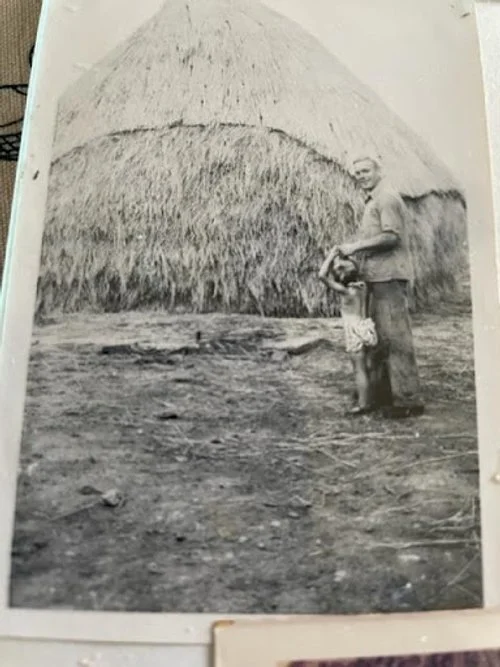Leen Times - A Lifetime Of Farming, Part One
As I sit here looking out of the window on yet another wet day and wonder at the fate of this harvest, I reflect on the 70 odd harvests I have seen before.
My dad left the navy after WW 2 and decided to go farming. He had no experience, although mother had, so took a job as a farm student for a year (which cost him £50!) on a mixed farm near 'the forest' (of Dean). I was still in a pram at the time and heard stories of that pram having the wheels frozen to the ground after being left outside for the 'fresh air' during the hard winter of 1947.
After that year father had got a tenancy of a 20 acre County Council farm near Cheltenham racecourse. This is where my first memories (now aged 3+) of a harvest come in -haymaking- spending hours in the field turning the cut grass over with a little fork. The smell, the sun, the laughter and most important of all, the food and orange juice (for me) that appeared in a huge wicker basket.
A couple of years later my dad somehow managed to get the tenancy of 120 acres of a rundown farm near Gloucester. Here were milking cows (just 12 to start with), lots of other cattle, pigs, chickens, an orchard and some fields of Wheat, Barley, Oats as well as Potatoes and other root crops. I now had a little brother and we used to roam with our catapults, but mostly ‘help’ where we could on the farm. I well remember the excitement of the 'binder' arriving and learning to put the sheaves in 'stooks' of 8- each sheaf had to be the right way round and stood up in the stubble before being laid against each other.. properly - otherwise the stook would be 'down' within a day or two and exposed to the weather. The lasting memory is of sore knees and arms!
A few weeks later the sheaves were pitched (with a pitch fork - a tool I would later learn to use with some dexterity!) and stacked onto a trailer pulled by our one farm tractor - a Standard Fordson. This was then towed into the Rick yard at the farm and unloaded onto a bed of branches and hedge trimmings (to keep it off the ground) Sheaves were pitched to the farm ‘expert’ who would deftly turn the heads in and build the stack higher and higher until the ‘rick’ had been formed. Once the fields had been cleared and all the ricks built ‘thatching’ could begin, The ladders came out, piles of ‘spars’ and rolls of twine would appear and the farm expert would set about putting a temporary waterproof cover on it.
A Small Tony with father Geof Norman at Southfield Farm, Gloucester, c1950
Several months later there was more excitement at the farm when the Threshing Machine rolled into the yard. Piles of huge hessian bags – to hold over 2 hundred weight (100 kilos!) of corn-were hired from a local firm and known as ‘Gopsel Browns’. The huge machine was set up beside the rick attached to a tractor by a whirring belt. Behind it was another tractor with a baler attached that would bale the straw with wire ties, these were stacked nearby to be moved later. Chaff would be blowing into a huge pile- the noise and the smell of oil was terrific. To the side would be the pile of empty sacks quickly being attached to the Thresher. These, when full would be dragged away and stood upright for the ‘sewer’ to seal the tops with a heavy needle and jute thread. 2 men would then use a sack lifter and a stout stick between them to flip the sacks onto a trailer, to be dragged into place by a third man. The trailer was then driven round to the ‘granary’ where they would be carried up the stone steps and stored. In all there were up to 10 men involved and I well remember them all coming into the outside of the farmhouse to have their breaks. Sat on benches, having chunks of bread, fat ham or cheese, apples and gallons of tea poured from huge metal tea pots- later in the day this was replaced by mugs of Cider from the farm barrels. Again, there was plenty of joking and laughter but the job was soon over and the whole lot trundled off down the road.
Those harvests were a golden time for young boys, full of excitement with waiting for the rabbits to run out from the last lap of the binder to chasing the rats and mice from the last few sheaves to be moved from the rick.
Combine Harvester
With the first combine (middle 50’s for us) came smaller sacks, just 1 hundredweight and a quarter (about 60 kilos). The bags were filled and tied on the machine, having been threshed by it. They were slid down a chute and when about half a dozen had collected they were released in a pile onto the ground. Our job (I had by now been promoted to ‘tractor driver’) was to go round and collect these- and woe betide anyone that left any in the field! They were then driven back to the farm and placed in the granary for safe keeping. Sometimes the corn was cut a bit damp and we had to line up the bags and open all the tops and let the sacks ‘breathe’. All the straw was baled up by a ‘pickup baler’ with sisal string (much better for the hands than wire) these bales were pitched onto trailers and taken and stacked in the barns.
Technology soon moved on and the bagging unit was replaced by a bulk hopper that could be unloaded directly into a tipping trailer. The corn could now be handled in bulk and moved around the farm buildings and stores with augers or tractor front end loaders.
Little has changed, except the capacity (and price!) to this day.
This is the combine that Frank Smith was driving at The Leen in 1970


